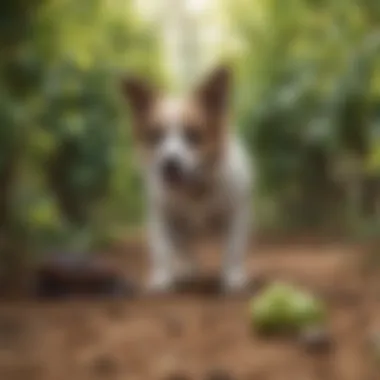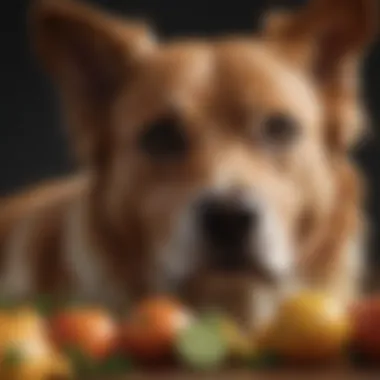The Hidden Risks of Certain Fruits and Vegetables for Dogs: A Comprehensive Guide


Animal Species Profile
Dogs, considered as man's best friend, are domesticated mammals known for their loyalty and companionship. With various breeds displaying unique physical characteristics and appearance, ranging from size to coat texture and color, dogs have adapted well to various environments. Their natural habitat can vary from urban settings to rural areas, and their distribution can be found globally due to human companionship. Known for their social nature, dogs exhibit diverse behaviors and interactions, from playful romps to protective stances within their pack hierarchy. Understanding the underlying characteristics of dogs can provide valuable insight into their dietary needs and potential risks associated with specific fruits and vegetables.
Pet Care & Tips
Choosing the right dog breed aligns with one's lifestyle, considering factors such as size, energy levels, and grooming requirements. Basic care involves providing a balanced diet, adequate exercise, and mental stimulation for a dog's overall well-being. Creating a suitable habitat with bedding, toys, and safe spaces is crucial for a dog's comfort. Health and wellness tips focus on regular veterinary check-ups, vaccinations, and parasite prevention to ensure longevity and quality of life for dogs. Training techniques encompass positive reinforcement, consistency, and patience to mold desired behaviors and foster a strong bond between pets and owners.
Introduction
In the realm of pet care and nutrition, it becomes imperative to delve into the intricacies surrounding the diet of our furry companions. This article unravels the enigmatic world of certain fruits and vegetables that pose potential dangers to dogs. While many may assume that all fruits and vegetables are safe for canine consumption, the reality unveils a different narrative. By comprehensively exploring the hazards associated with specific foods, pet owners can adopt a more vigilant approach towards their pet's well-being.
Understanding which foods to avoid can significantly impact the health and longevity of our beloved dogs. The significance of this topic lies in shedding light on the detrimental effects that seemingly harmless foods can have on our pets. By acknowledging and assimilating this crucial information, dog owners can actively safeguard their furry companions from unnecessary health risks.
Amidst the myriad of information available on pet nutrition, the focus on toxic foods often takes the back seat. Through this article, we aim to bring forth the lesser-known yet pivotal details regarding certain fruits and vegetables. The exploration of toxicity concerns and digestive sensitivities acts as a cornerstone in equipping readers with the knowledge necessary to make informed decisions when it comes to their pet's diet.
With an arsenal of insights into the perils lurking within our kitchens, pet owners can embark on a journey of enhanced awareness and conscientious feeding practices. By discerning the dangers posed by common foods, we pave the way towards a healthier and safer environment for our canine companions.
Why Some Fruits and Vegetables AreHarmful to Dogs
In this section, we delve into the critical aspects of why certain fruits and vegetables can pose significant risks to our furry companions. Understanding the rationale behind this issue is pivotal in ensuring the well-being and safety of our canine friends. Dogs have a unique digestive system that may not be compatible with all types of fruits and vegetables, leading to various health complications. By exploring the specific elements and considerations related to the harmful effects of certain foods on dogs, we shed light on the importance of being cautious and informed when it comes to their diet.
Toxicity Concerns
Impact of Toxic Compounds


The impact of toxic compounds on dogs' health is a pressing issue that requires attention. These compounds, found in certain fruits and vegetables, can have detrimental effects on a dog's overall well-being. Identifying the key characteristic of these toxic compounds is essential in understanding why they pose a threat to canine health. Despite being a common element in nature, these compounds can be harmful when consumed by dogs, making them a crucial topic of discussion in this article. Exploring the unique features of toxic compounds and their potential advantages and disadvantages offers valuable insights into the risks associated with allowing dogs to ingest certain fruits and vegetables.
Dangerous Effects on Canine Health
The dangerous effects that certain fruits and vegetables can have on canine health are profound. From organ dysfunction to neurological issues, these foods can trigger a range of health problems in dogs. Understanding the key characteristics of these effects is pivotal in comprehending the gravity of the situation. By highlighting why these effects are significant in the context of this article, we underscore the importance of avoiding specific fruits and vegetables to safeguard our pets' well-being. Delving into the unique features of these health risks and their implications provides a holistic view of the potential dangers dogs may face when exposed to harmful foods.
Digestive System Sensitivities
Issues with Digesting Certain Foods
Dogs may encounter various challenges when digesting certain fruits and vegetables, leading to digestive issues and discomfort. Exploring the specific aspects related to these digestive challenges sheds light on the implications for canine health. Understanding why some foods are harder to digest than others is crucial in mitigating potential digestive distress in dogs. By unpacking the key characteristics of foods that may pose digestion challenges, we emphasize the importance of selecting ingredients carefully to ensure our pets' well-being.
Potential Allergic Reactions
Potential allergic reactions to fruits and vegetables can pose serious risks to dogs' health. Allergies can manifest in different ways, affecting dogs' skin, gastrointestinal system, or respiratory health. Identifying the key characteristics of potential allergic reactions is vital in recognizing the signs and symptoms early on. By highlighting why allergic reactions are a significant concern in the context of this article, we stress the importance of monitoring dogs for any adverse reactions to certain foods. Exploring the unique features of allergic responses and their potential consequences offers valuable insights into safeguarding our pets from such health risks.
Common Fruits Dangerous for Dogs
In exploring the realm of Common Fruits Dangerous for Dogs, we uncover a critical aspect of pet care that is often overlooked. Understanding the hazards associated with certain fruits can significantly impact the health and well-being of our canine companions. By delving into specifics such as toxicity risks, organ implications, and other detrimental effects, pet owners can make informed decisions to safeguard their furry friends. The significance of highlighting Common Fruits Dangerous for Dogs lies in the potential life-threatening consequences that can arise from unwittingly feeding these harmful foods to our beloved pets. Ensuring the safety and dietary health of dogs is paramount, making knowledge about unsafe fruits a vital component of responsible pet ownership.
Grapes and Raisins
Toxicity Risks
Grapes and raisins pose a significant threat to dogs due to their toxicity risks. The ingestion of even small quantities of these fruits can lead to severe health complications, including acute kidney failure. The specific aspect of Toxicity Risks associated with grapes and raisins is particularly concerning as dogs are unable to metabolize certain compounds present in these fruits, leading to detrimental effects on their renal function. Understanding the gravity of Toxicity Risks is crucial for pet owners to prevent accidental ingestion and mitigate potential harm to their canine companions. Despite their popularity among humans, grapes and raisins stand as hazardous choices for dogs, reinforcing the importance of highlighting these Toxicity Risks within the context of this article.


Impact on Kidney Function
The Impact on Kidney Function resulting from the ingestion of grapes and raisins can be catastrophic for dogs. These fruits contain substances that can trigger a chain of events leading to kidney damage and failure in canines. The key characteristic of this impact lies in the unique way these fruits interact with a dog's renal system, disrupting its functionality and potentially causing irreversible harm. Recognizing the direct correlation between grape and raisin consumption and kidney function impairment is essential for pet owners to exercise caution and prevent adverse consequences. This section sheds light on the alarming implications of grapes and raisins on canine kidney health, underscoring the need to avoid these fruits to protect the well-being of our furry companions.
Vegetables to Steer Clear of Feeding Dogs
In delving into the dangers associated with feeding certain fruits and vegetables to our canine companions, it is crucial to shed light on the significance of understanding which vegetables pet owners should steer clear of when it comes to their dog's diet. Some vegetables, such as onions and garlic, can pose severe health risks to dogs, making it imperative for pet owners to be aware of these potential dangers. Ensuring that dogs are not exposed to harmful vegetables plays a pivotal role in safeguarding their well-being and overall health. By being mindful of the vegetables that can be detrimental to dogs, pet owners can prevent unnecessary health complications and protect their furry friends from harm.
Onions and Garlic
Hemolytic Anemia Concerns
When it comes to onions and garlic, one of the most concerning issues for dogs is the risk of hemolytic anemia. This condition involves the abnormal breakdown of red blood cells, leading to a range of serious health implications for our canine companions. Hemolytic anemia concerns pose a significant threat to the overall well-being and vitality of dogs, making it crucial for pet owners to avoid feeding these vegetables to their furry friends. The unique feature of hemolytic anemia concerns lies in its ability to disrupt the normal functioning of a dog's circulatory system, ultimately endangering their health. Understanding the detrimental effects of hemolytic anemia can guide pet owners in making informed decisions regarding their dog's diet, steering clear of foods that can trigger this dangerous condition.
Gastrointestinal Distress
In addition to hemolytic anemia concerns, onions and garlic are also notorious for causing gastrointestinal distress in dogs. Symptoms of gastrointestinal distress may include vomiting, diarrhea, abdominal pain, and loss of appetite, all of which can significantly impact a dog's quality of life. The key characteristic of gastrointestinal distress associated with onions and garlic is its potential to disrupt the digestive system of dogs, leading to discomfort and health complications. Understanding the unique features of gastrointestinal distress caused by these vegetables is essential for pet owners to recognize and address any signs of digestive discomfort in their furry companions. By being vigilant and mindful of the risks of gastrointestinal distress, pet owners can avoid inadvertently exposing their dogs to harmful vegetables and prioritize their well-being.
Avocado
Cardiac Toxicity
Avocado poses a serious risk to dogs due to its potential for causing cardiac toxicity. This condition can have detrimental effects on a dog's heart health, leading to increased risks of cardiac-related complications. Cardiac toxicity associated with avocado consumption is characterized by its ability to disrupt the normal functioning of a dog's heart, posing a grave danger to their well-being. By understanding the key characteristic of cardiac toxicity linked to avocados, pet owners can make informed choices regarding their dog's diet, steering clear of this harmful fruit to protect their pet's cardiac health.
Potential Breathing Difficulties


Apart from cardiac toxicity, avocados can also trigger potential breathing difficulties in dogs. Respiratory issues, such as difficulty breathing or labored breathing, can arise as a result of avocado consumption, posing a severe threat to a dog's respiratory system. The unique feature of potential breathing difficulties associated with avocados lies in its capacity to impede normal breathing patterns in dogs, jeopardizing their respiratory well-being. Recognizing the risks of breathing difficulties linked to avocados is essential for pet owners to avoid exposing their furry friends to this dangerous fruit and prioritize their respiratory health and overall well-being.
Handling Other Risky Foods
Nuts and Seeds
Obstruction Hazards:
Exploring the topic of obstruction hazards in nuts and seeds, it is evident that certain varieties such as almonds or walnuts can pose a particular risk to dogs due to their size and hardness. These hazards can lead to blockages in the digestive tract, causing discomfort and potential health issues for the canine. Understanding the key characteristic of obstruction hazards, primarily related to the size and texture of nuts and seeds, sheds light on why caution is essential in feeding these foods to dogs. Despite their nutritional value, the risk of obstruction hazards underscores the need for pet owners to be vigilant in monitoring their dog's food intake. Being aware of this unique feature and its downsides in the context of this article serves to educate readers on lesser-known dangers in canine nutrition.
Risk of Pancreatitis:
Delving into the risk of pancreatitis associated with nuts and seeds, it becomes apparent that the high-fat content in certain varieties can trigger inflammation of the pancreas in dogs. This risk factor, often overlooked in discussions on canine nutrition, underscores the importance of moderation and careful selection of food items. Highlighting the key characteristic of the risk of pancreatitis reveals why this aspect merits attention in the context of this article. While nuts and seeds can offer benefits, the potential for pancreatitis emphasizes the need for pet owners to exercise caution. Explaining the unique feature of the risk of pancreatitis and its implications within this article provides readers with a comprehensive understanding of potential health ramifications.
Xylitol-Containing Products
Moving on to the discussion of xylitol-containing products in the context of risky foods for dogs, it is essential to address the specific threats posed by this artificial sweetener. The inclusion of xylitol in various products can pose a significant hypoglycemia threat to dogs if ingested, leading to a sudden drop in blood sugar levels. This aspect, often underestimated by pet owners, serves as a critical consideration in canine diet management. By highlighting the key characteristic of the hypoglycemia threat linked to xylitol, this article aims to emphasize the potential dangers associated with seemingly harmless products. Understanding this unique feature and its drawbacks underscores the need for heightened awareness among dog owners to prevent accidental ingestion.
Potential Liver Damage
Potential Liver Damage:
Examining the implications of potential liver damage from xylitol-containing products, it becomes evident that this sweetener can adversely affect a dog's liver function if consumed in significant amounts. The potential for liver damage due to xylitol exposes a lesser-known risk factor that pet owners should be cognizant of. By elucidating the key characteristic of potential liver damage and its impact on canine health, this article sheds light on the importance of scrutinizing ingredient lists for xylitol content. Despite its advantages as a low-calorie sweetener in human products, the potential for liver damage in dogs makes it a hazardous choice. Describing this unique feature and its consequences within this article provides a comprehensive overview of the risks associated with xylitol-containing items.
Conclusion
In the intricate tapestry of canine nutrition, the conclusion serves as a vital cornerstone, underlining the significance of discerning food choices for our faithful companions. This section encapsulates a myriad of essential factors critical for the holistic well-being of our dogs. Exploring the adverse effects of specific fruits and vegetables on canine health, the conclusion acts as a beacon of caution, guiding pet owners towards prudent dietary decisions. By navigating through the complexities of what our furry friends can and cannot eat, we pave the path towards longevity and vitality for our four-legged family members.
Delving into the depth of the chosen foods to keep dogs safe, the conclusion unearths the paramount need for vigilance and awareness in pet nutrition. Through meticulous research and expert insights, the article elucidates the potential dangers lurking in seemingly innocuous fruits and vegetables, equipping pet owners with the knowledge to safeguard their dogs' health. It emphasizes the proactive role individuals must play in mitigating risks and prioritizing the welfare of their canine counterparts. By instilling a sense of responsibility and informed decision-making, the conclusion fosters a culture of conscientious pet care, elevating the standards of animal welfare in the process.
Moreover, the conclusion probes beyond mere dietary lists, transcending into a realm of informed choices and nutritional empowerment. By shedding light on the nuanced intricacies of canine digestion and metabolic processes, the section empowers readers to make educated choices aligned with the physiological needs of their pets. It champions the adoption of a preventative approach, urging pet owners to err on the side of caution when it comes to sharing food with their dogs. Through a lens of prudence and care, the conclusion cements the importance of treating our pets not just as companions, but as sentient beings deserving of mindful stewardship and respect.
In essence, the conclusion encapsulates the essence of responsible pet ownership, encapsulating the fine balance between love and caution in nourishing our canine friends. It epitomizes the fusion of knowledge and care, weaving a narrative of wellness and safety for our beloved animals. By instilling a sense of duty and accountability in every pet owner, the conclusion emerges as a quintessential guidepost in the realm of canine nutrition, underscoring the enduring bond between humans and their loyal canine companions.







